What is tidal energy?
Tidal energy is a source of undefinedundefined energy powered by the movement of the sea as it rises and falls with the tides.
In this article you can learn:
- What causes tides
- How tides are used to generate electricity
- Where tidal turbines work best
- What the advantage and disadvantages of tidal energy are
This resource is suitable for energy and sustainability topics for primary school learners.
Video - What is tidal energy?
Find out about tidal energy and what the advantage and disadvantages of tidal energy are in this short video.
Ah what a lovely moonlit evening.
But, you know, the moon doesn't just look beautiful.
It also causes the ocean's tides. Good, eh?
Meet Tidal-power - Tida, to you and me.
Her face is the moon, and her body is the ocean. The gravitational pull of her moony head moves around her watery body.
Gravity is a force that attracts things to each other – the bigger the object, the bigger the attraction.
The Earth is pretty big and that's why if you drop something it falls so quickly.
The moon is pretty big too.
In fact it's so big that it actually causes the Earth's oceans to bulge out.
The oceans that are closest and furthest away from the moon bulge at the same time - creating high tide in those areas.
As the moon moves around the earth, its gravity raises and lowers our sea levels, making two high tides and two low tides every day, everywhere in the world.
Let's go to the Pentland Firth to find out how all those tides give us energy.
Hello again, Tida!
So, thanks to the moon, waves flow back and forth with the tide.
And we can use that kinetic energy - thank you Tida - to spin the huge turbines in the Pentland firth.
The turbines turn a generator, which produces electricity. This runs all the way along the sea floor in giant cables, to power nearly 4000 homes.
If you put turbines in a place with strong tides you can generate a lot of electricity (just don't go swimming there!) and tidal power is very reliable.
Remember - the change between low and high tide happens twice a day.
The big disadvantage of tidal power is that it costs a lot of money to get all those turbines and cables underwater. And they could have negative effects on the environment – confusing or even injuring sea-life.
But, in the main, Tida is a clean, renewable source of energy.
Ah… she loves a good wave!
What causes tides?
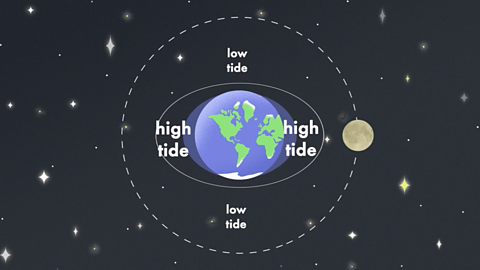
tidesThe rise and fall of the sea caused by the gravitational pull of the moon. Most places on the coast have two high tides and low tides each day. in the ocean are caused by the gravityA force that pulls things towards the centre of a mass. Gravity is much stronger for bigger masses like planets and stars. of the moon pulling the Earth towards it.
Where oceans face the moon, the water is pulled most and builds up in a bulge. This is a high tide. The Earth is pulled towards the moon more than the ocean on the opposite side of the planet. This causes another high tide.
As the moon moves around the planet, these tides move around with it, causes two high tides and two low tides each day. This moving water has a lot of kinetic energyEnergy that an object possesses because of its movement. A ball being thrown through the air has kinetic energy because it is moving. When water moves this is also an example of kinetic energy. that can be used to generate electricity.
Learn more about tides and the power of the sea with Isla and Connor: Coastal erosion: What are tides?

What is gravity?
Gravity is a force that pulls objects towards each other. Earth’s gravity is a bit like a magnet which keeps our feet on the ground and is the reason we don't float away. into space when we jump.
It is quite a weak force for small objects but gets much stronger for larger objects. We only really notice the gravity of massive objects like the Earth, moon, Sun or other stars and planets.
Gravity is an important force in the solar system and universe. In our solar system, the Sun is the biggest object and has the strongest gravity. This keeps all of the planets in their orbit around the Sun.
The moon is much smaller than the Sun. The reason its gravity is strong enough to cause tides is because the moon is about 400 times closer to us than the Sun.
Not sure what gravity is? Find out with this short video.
Isaac Newton. Isn't he the guy who discovered gravity?
Great. So what's gravity?
Ah, gravity is the force that makes objects fall towards the ground and without gravity, we'd all float.
You're right! The force of gravity is weaker on the moon than on the Earth.
So here you can jump much higher.
Gravity also act between the moon and the Earth and keeps the Earth in orbit around the Sun.
Fascinating stuff. And thanks for showing me the effects of gravity. It's clearly a very important force.
How do the tides create electricity?
The rise and fall of the tides causes water to move back and forth. This can be used to turn the blades of tidal turbineA turbine is a machine that turns the movement of liquid or gas into energy that can be used. In a simple turbine water or air push against turbine blades and spin them round. The spinning blades turn a long pole called a shaft. The shaft can then turn other pieces of machinery, such as a generator that is used to produce electricity.. Each turbine turns a generatorA machine that is used to make electricity. When the generator head is turned, this energy is converted to electrical energy. which converts the kinetic energy of the movement of the water into electrical energy. This electricity is then passed through underwater cables and is then used to power homes.
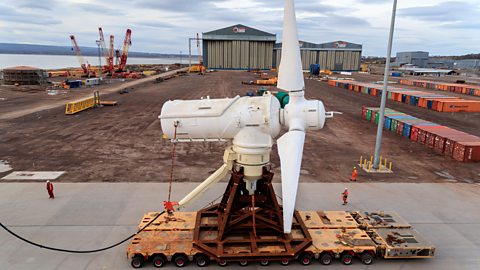
Image caption, A tidal turbine being prepared for installation near Nigg, Scotland. (arild lillebø / Alamy Stock Photo)

Image caption, Once ready for installation, the tidal turbine is moved from the land onto a ship. (Alstom)
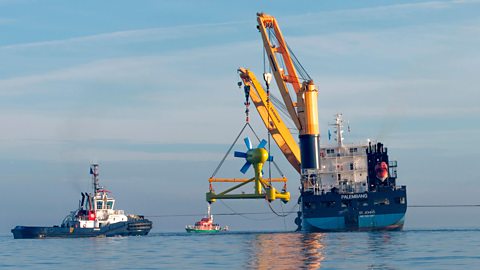
Image caption, Tidal turbines are installed on the ocean floor with the help of powerful ship cranes. This turbine is being installed in the Iroise sea, off of France. (BIOSPHOTO / Alamy Stock Photo)
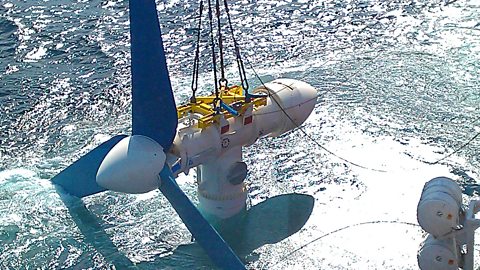
Image caption, Tidal turbines have huge blades that are turned by water moving between high and low tides. (Atlantis Resources Corporation)
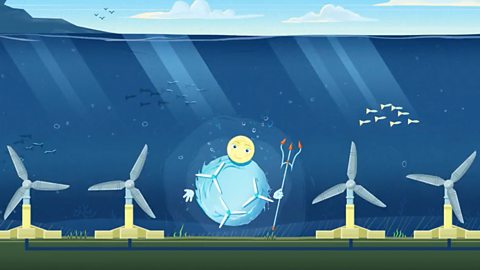
Image caption, Most tidal turbines are placed on the sea floor. The rising and falling tides cause the turbines to turn the generator that produces electricity.
1 of 5
Where do tidal turbines work best?
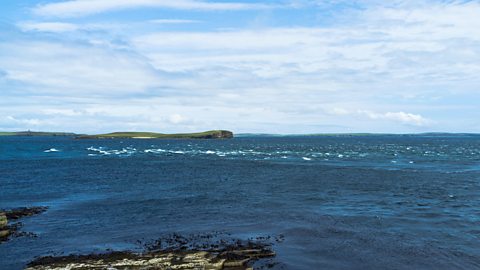
The best place to put tidal turbines is somewhere with strong tides.
Tides are stronger where the sea narrows between different areas of land. This means lots of water has to pass through a small gap. More moving water has more kinetic energy to spin the turbines, so more electricity can be generated.
The Pentland Firth between the north coast of mainland Scotland and Orkney is home to a number of tidal turbines.
Visit the Pentland Firth with Isla and Connor as they explore features of coastal erosion on a journey from Stromness in Orkney to Scrabster in the north of mainland Scotland: Coastlines: erosion

The advantages and disadvantages of tidal energy
Advantages of tidal energy
- Very reliable. There are two high tides and two low tides every day of the year, everywhere in the world, no matter what the weather.
- Unlike renewable energies that rely on the wind and sun, tidal power is constant as the tides are always changing and will never stop.
- It is a clean and renewable source of energy.
Disadvantages of tidal energy
- Constructing a tidal power plant can be very expensive.
- Tidal power plants can have a negative effect on the environment and marine life.
- Tidal power plants can only be built in locations where there are strong tides, meaning their locations are limited.

Key words about tidal energy
Sorry, something went wrongCheck your connection, refresh the page and try again. – These are the rising and falling levels of the ocean’s surface caused by the gravitational pull of the moon.
Sorry, something went wrongCheck your connection, refresh the page and try again. – An invisible force which pulls objects towards each other. It is only noticeable for large objects like stars and planets… The Earth’s gravity is what makes things fall and what keeps us on the ground.
Sorry, something went wrongCheck your connection, refresh the page and try again. – Gravitational pull is the force that pulls objects towards planetary bodies such as planets and moons.
Sorry, something went wrongCheck your connection, refresh the page and try again. – Energy that an object possesses because of its movement. A ball being thrown through the air has kinetic energy because it is moving. When water moves this is also an example of kinetic energy.
Sorry, something went wrongCheck your connection, refresh the page and try again. – A simple turbine has a shaft and blades that turn movement into energy. Usually water or air push the blades and turn the shaft. Turbines are used to turn the generator.
Sorry, something went wrongCheck your connection, refresh the page and try again. – A machine that is used to make electricity. When the generator head is turned, this energy is converted to electrical energy.
Test your knowledge
Quiz
Challenge
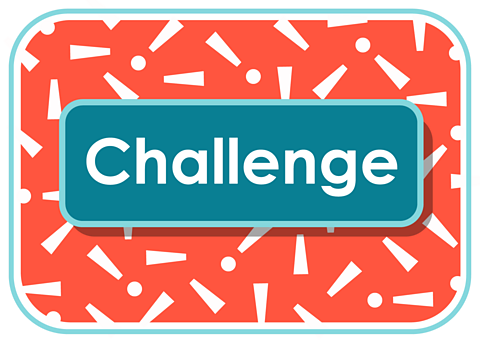
What would you ask a scientist?
Imagine you get the chance to ask three questions to the world’s leading tidal wave scientist.
Think of three questions you would ask him or her about tidal energy.
Can you find the answers to your questions?
More on Sustainability
Find out more by working through a topic
- count23 of 28
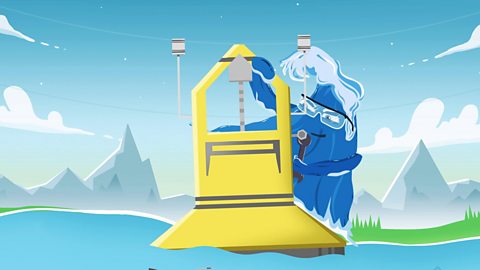
- count24 of 28
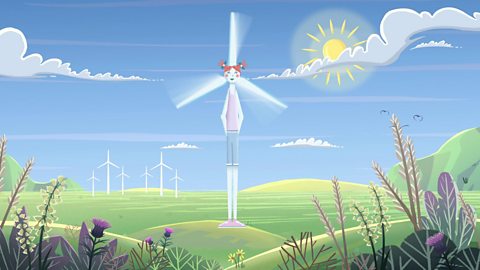
- count25 of 28
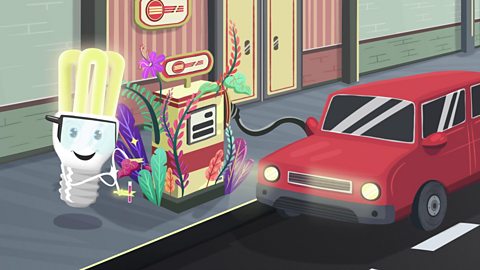
- count26 of 28
